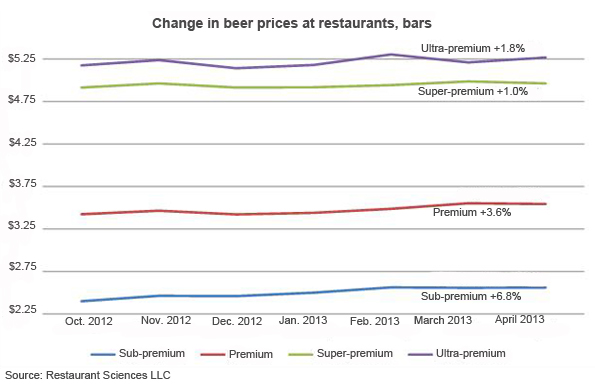Alcohol pricing in restaurants and bars over the past seven months has increased dramatically, with wide variations by segment, and researchers suspect restaurants may be making up for lost margins during the recession.
Restaurant Sciences LLC, a market research firm that tracks food and beverage consumption across the foodservice spectrum in North America, tracked millions of transactions at a period roughly between October 2012 and April 2013, breaking down price increases on various product categories by segment.
According to the research, mass-market beers, like Budweiser and Pabst Blue Ribbon, showed the highest price increases within the beer category — except in family dining concepts, where beer prices for that level of product remained steady. Despite the popularity of “ultra-premium” craft beers, price increases for those products were relatively low.
RELATED
• Building craft beer sales at restaurant chains
• Engineering bar menus for quality, speed
• Beverage Trends at NRN.com
For liquor, the biggest increases were seen in fine dining — where the price of spirits grew more than 11 percent — and also in family dining, where prices increased 4.5 percent on average. The casual dining and bar/nightclub sectors, where most spirits are sold, saw virtually no increase.
Wine prices also inched up during the period, with the biggest increases seen at the family-dining and fine-dining levels — though the data may indicate consumers are migrating to more expensive bottles, said Chuck Ellis, president of Restaurant Sciences.
The report, however, does not explain why prices went up during the research period.
Ellis said it’s difficult to gauge whether wholesale prices are increasing overall because states have differing regulations and controls on alcohol sales. The fact that results varied dramatically by segment, however, indicates that wholesale price increases may not be entirely to blame, he said.

“I think restaurants are coming out of three-and-a-half years of tough times where they had to eat a lot of margin,” he said. That was particularly true at the fine-dining tier, he noted, which was hit hard by the recession, and where average drink prices across the board increased “with a vengeance.”
At the fine-dining level, for example, the price of spirits grew 11 percent on average during the six-month period of November 2012 through April 2013, while liquor pricing within the casual dining segment remained flat, with little to no increase.
Looking at the period of October 2012 through March 2013, wine prices in the fine-dining sector increased 5.3 percent, the researchers found.
Ellis said there’s an argument that some of that shift is the result of consumers trading up, buying an $11 glass rather than the $10 glass. “For wine, we know that’s part of it,” he said. “But not as much for spirits. About two-thirds of that increase was due to price increases and one-third was consumer mix.”
Craft beer prices the steadiest
Continued from page 1
Ellis said he was surprised to see that even with consumer interest growing for craft beers, mass-market beers, like Budweiser, Coors Light, Miller Lite and Pabst Blue Ribbon, showed the highest rate of increase within the beer category. Prices jumped 3.6 percent for “premium” brands and 6.8 percent for “sub premium” brands during the seven-month period from October 2012 through April 2013.
Those showing more moderate price increases were craft, or “ultra-premium” beers, which rose 1.8 percent in price, as well as “super premium” beers, which increased in price by about 1 percent on average.
“While all the attention has been on craft beers, the price of mainstay brands in the mid-price tier have risen more dramatically," he said. "And traditionally lower-priced beers, such as Pabst Blue Ribbon, have seen sizeable double-digit price increases in restaurants as well as bars and nightclubs.”
That could be explained in part by the growing popularity of beers like Pabst Blue Ribbon among hipsters, who have embraced a retro attraction to the brand, Ellis said.
Still, prices for sub-premium beers remained under about $2.75 during the period, while the ultra-premium craft beers topped $5.25.
And “family restaurants” with an average check under $40 tended to hold beer prices steady during the period, the survey found. Those family restaurants, however, appeared to raise prices on wine.
Wine prices at family-dining restaurants jumped 8.36 percent during the period, followed by a 5.35-percent increase at fine-dining concepts, the research found.
At mid-priced casual-dining concepts, however, wine prices grew a modest 1.90 percent on average, and pricing increased 1.99 percent at upscale-casual restaurants, the study found.
The wine data reflects trends at more than 5,000 restaurants, including $289 million in purchases of wine by the glass, bottle or carafe.
Contact Lisa Jennings at [email protected].
Follow her on Twitter: @livetodineout




